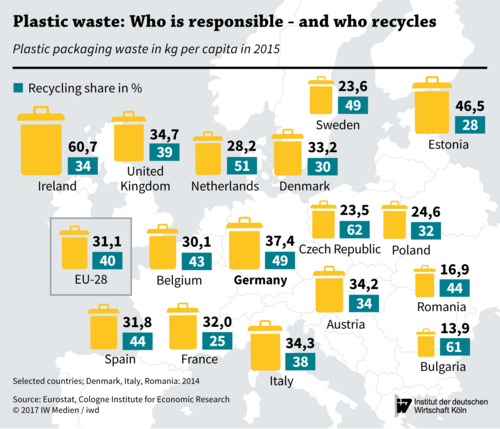In hopes of getting its growing volumes of plastic waste under control, the EU will be publishing a plastics strategy in early December – and there is certainly plenty to do. A study by the Cologne Institute for Economic Research (IW) shows how the amount of plastic packaging waste per capita differs between member states.
Plastics Strategy: Wrapping the EU waste problem
Vast islands of plastic are floating in the world’s oceans. Since plastic is very slow to break down, and is absorbed by plants, animals and people through drinking water and the food chain, many environmental researchers now believe it poses as great a threat to Earth’s ecosystem as the greenhouse gas carbon dioxide. This problem won’t go away on its own – far from it in fact, since the amount of plastic being produced worldwide continues to grow. The EU plastic manufacturers association Plastics Europe reports that 322 million metric tons were produced in 2015. That's seven times as much as in the mid-1970s.
According to estimates, at least a quarter of world plastic production is used for packaging, which inevitably winds up in the bin sooner or later – even in Europe: From 2005 to 2015, the amount of plastic packaging waste in the EU-27 increased by 12 percent. In Germany, it increased even by 29 percent. Economic output did grow even more quickly over that same period, increasing by 28 percent in the EU and 31 percent in Germany. So the good news is that Europe is producing less plastic packaging waste per unit of GDP than in the past. But this progress will not be enough to effectively control the flood of plastic.
To limit the production of plastic waste to an environmentally sustainable level, the EU is working on a plastics strategy that is supposed to be published in early December. The EU Plastic Bags Directive took a first step in this direction with its goal of reducing annual consumption to 40 bags per EU citizen. Germany has opted to implement this directive through voluntary self-regulation in the retail sector. So far, the results have been good: it was only in July 2016 that many retail businesses stopped handing out plastic carrier bags for free, but Germans’ annual consumption for 2016 has already dropped to just 45 bags per capita, versus 68 the year before.
Even so, the overall rubbish situation in Germany leaves a lot to be desired: At 37.4 kilograms of plastic packaging waste per person, Germany produces 6 kg more than the European average. Even certain member states with a comparably high per-capita GDP produce less plastic waste, including Austria, Denmark, and especially Sweden and the Netherlands. In fact, a few countries, such as Spain, Italy and the Netherlands, have even managed to reduce their per-capita production of plastic packaging waste since 2005 – unlike Germany.
Part of the explanation for Germany’s poor performance in reducing plastic waste relates to the fact that the share of reusable beverage packaging has been declining for years despite a deposit system. Nearly 60 percent of the bottles were reusable in 2006, but that figure was less than 46 percent in 2015. Still, Germany is hardly Europe’s worst environmental offender.
In fact, when it comes to recycling, Germany is one of the better ones: In Germany, half of plastic packaging waste is recycled, versus an EU average of just 40 percent. But the real shocker comes when we look at what happens to the rest of that plastic packaging: almost all of Germany’s non-recycled plastic is at least reused as a source of energy – but in other countries, far too much of it is still dumped right into landfills. This is what happens to over 60 percent of plastic waste in Greece, Poland and Latvia, for example. And plastic that is neither recycled nor incinerated usually ends up scattered to the winds or floating down a river somewhere.

Wichtige Lichtblicke
Die jüngsten Zahlen zum Wachstum des Bruttoinlandsprodukts zeigen: Die Rezession in der Eurozone ist beendet, der Länderclub hat auf den Wachstumspfad zurückgefunden. Auch in den Krisenländern zeigt sich Licht am Ende des Tunnels – vor allem in Portugal. Das ...
IW
Barrieren erschweren den Import
Die deutsche Industrie ist auf bezahlbare und zuverlässige Rohstofflieferungen angewiesen. Doch die Exportländer erschweren den Handel.
IW
